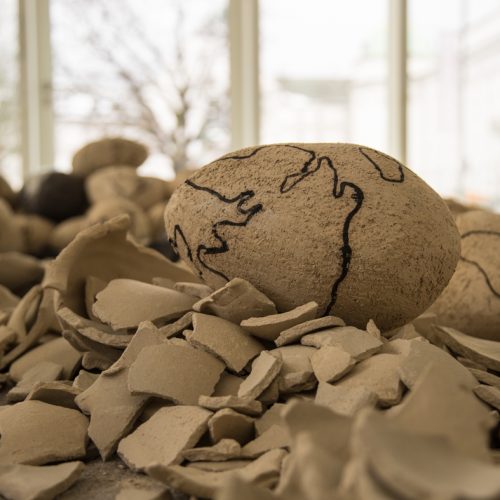worlds







Images by Daniel Jarosch and Judith Klemenc
2020. Kachelmasse, Barro Negro, Engobe. je 30 × 30 x 50 cm
2020. tile-body, barro negro, engobe. 30 × 30 x 50cm each
[D] Wie bringen wir die Welt zur Welt? Dieser Frage sind in einem feministischen Kontext insbesondere die Italienerinnen der Philosophinnen-Gruppe DIOTIMA nachgegangen. Und diese Formulierung muss sehr wohl ganz beim Wort genommen werden. Sie greift die „mütterliche“ Tätigkeit des Gebärens, aber auch das „mütterliche“ Werk des Spracherwerbs auf, also die beiden markanten Punkte des Eintritts einer Person in die Welt. Die Welt zur Welt bringen wird hier als Arbeit am Symbolischen verstanden, indem es dazu anregt, das Augenmerk darauf zu richten, wie die Welt aus der Sprache und dem Denken der einzelnen Person, aber auch aus dem Sprechen verschiedener Personen hervorgeht. Unser In-der-Welt-Sein wird als Beziehung zur Welt lebendig, die durch Sprechen entsteht, vermittelt wird und gerade durch Sprechen auch offen für Veränderung bleibt. Die Geschlechterdifferenz kann sich dabei als zentrale Vermittlungsinstanz erweisen. Judith Klemenc stellt mit ihrer Arbeit eine Frage, die einen Schritt darüber hinausgeht: wie die Welten (hier sind es zwei, eine hellhäutige Welt mit schwarzen Konturen und weiß verbleibenden Kontinenten und eine dunkelhäutige Welt mit weiß ausgefüllten Kontinenten) zur Welt bringen, und wie kann es möglich sein, andere Welten zur Welt zu bringen? Vielleicht Welten, in denen die Kontinente nicht mehr weiß sind, sondern bunt, nuanciert, plural usw.
[EN] How do we give birth to the world? This question has been explored in a feminist context, especially by the Italian women of the philosophers’group DIOTIMA. And this formulation can be taken literally. It takes up the “maternal” activity of giving birth, but also the “maternal” work of language acquisition, that is, the two distinctive points of a person’s entry into the world. Giving birth to the world is understood here as work on the symbolic in that it draws attention to how the world emerges from the language and thinking of the individual person but also from the speaking of different persons. Our being in the world becomes alive as a relationship to the world, which is created trough speech, conveyed through speech and remains open to change, especially through speech. Gender difference can prove to be a central mediating factor. In her work, Judith Klemenc poses a question that goes one step further: how do worlds (here there are two, a light-skinned world with black contours and continents remaining white and a dark-skinned world with continents filled with white) give birth, and how can it be possible to give birth to other worlds? Perhaps worlds in which the continents are no longer white, but colorful, nuanced, plural etc.
How do we give birth to the world? This question has been explored in a feminist context, especially by the Italian women of the philosophers’group DIOTIMA. And this formulation can be taken literally. It takes up the “maternal” activity of giving birth, but also the “maternal” work of language acquisition, that is, the two distinctive points of a person’s entry into the world. Giving birth to the world is understood here as work on the symbolic in that it draws attention to how the world emerges from the language and thinking of the individual person but also from the speaking of different persons. Our being in the world becomes alive as a relationship to the world, which is created trough speech, conveyed through speech and remains open to change, especially through speech. Gender difference can prove to be a central mediating factor. In her work, Judith Klemenc poses a question that goes one step further: how do worlds (here there are two, a light-skinned world with black contours and continents remaining white and a dark-skinned world with continents filled with white) give birth, and how can it be possible to give birth to other worlds? Perhaps worlds in which the continents are no longer white, but colorful, nuanced, plural etc.
Elisabeth Schäfer
